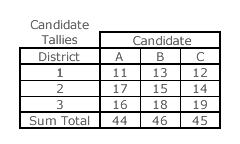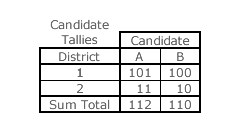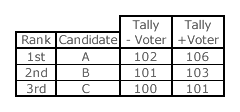Evaluations: General Criteria 1
Summability Criterion

A large constituency may or may not be subdivided into smaller arbitrary voting districts with a separate election count in each one. If each candidate tally in a constituency-wide election is identical to the summation of all the individual district tallies for that candidate, then the summability criterion is satisfied.
In the example opposite, the constituency is divided into three separate districts. Having the highest overall tally of 46, candidate B wins this election. In common with all other positional voting systems, it makes no difference using GV/CHPV whether the tally of 46 was generated in one constituency count or whether the three district counts of 13, 15 and 18 were later summed to the total tally of 46.
GV/CHPV therefore satisfies the summability criterion.
For those voting systems that meet the summability criterion, an 'order function' can be specified. It relates to the amount of information that must be passed from each district to the central count to determine the constituency winner. For positional voting systems such as GV/CHPV, only the one tally for each candidate needs to be communicated. The order function here is simply N; where N is the number of candidates. This minimal order function (when compared to N2 and especially N!) enables a quick and straightforward count process.
Consistency Criterion

Suppose the electorate within a constituency is divided into any two arbitrary districts and the same candidate is ranked top in both these districts. To satisfy the consistency criterion, this candidate must always win when the constituency is undivided.
In the example opposite, the constituency is divided into two random districts and candidate A is ranked first in both. Adding the two district tallies for each candidate only confirms that candidate A is the election winner. Like all positional voting systems, it is impossible by summing tallies for candidate A to be beaten by B when A is ahead in both districts.
GV/CHPV hence satisfies the consistency criterion.
Participation Criterion

Adding ballots that prefer candidate X to Y should never change the winner to Y from X. If this statement is always true for any election held under a particular voting system, then this system complies with the participation criterion.
In the CHPV example opposite, candidate A is initially ahead of B by a tally of 102 to 101. If the new voter also prefers A to B (by a weighting of 4 to 2 here), then in any positional voting system A must pull further ahead of B and win the election. As B is also preferred to C by the new voter (by a weighting of 2 to 1 here), then B must pull ahead of C too. It is always better for a voter to vote than to abstain.
GV/CHPV therefore satisfies the participation criterion.
Proceed to next page > Evaluations: General Criteria 2
Return to previous page > Evaluations: Introduction (Ranked Ballot)
